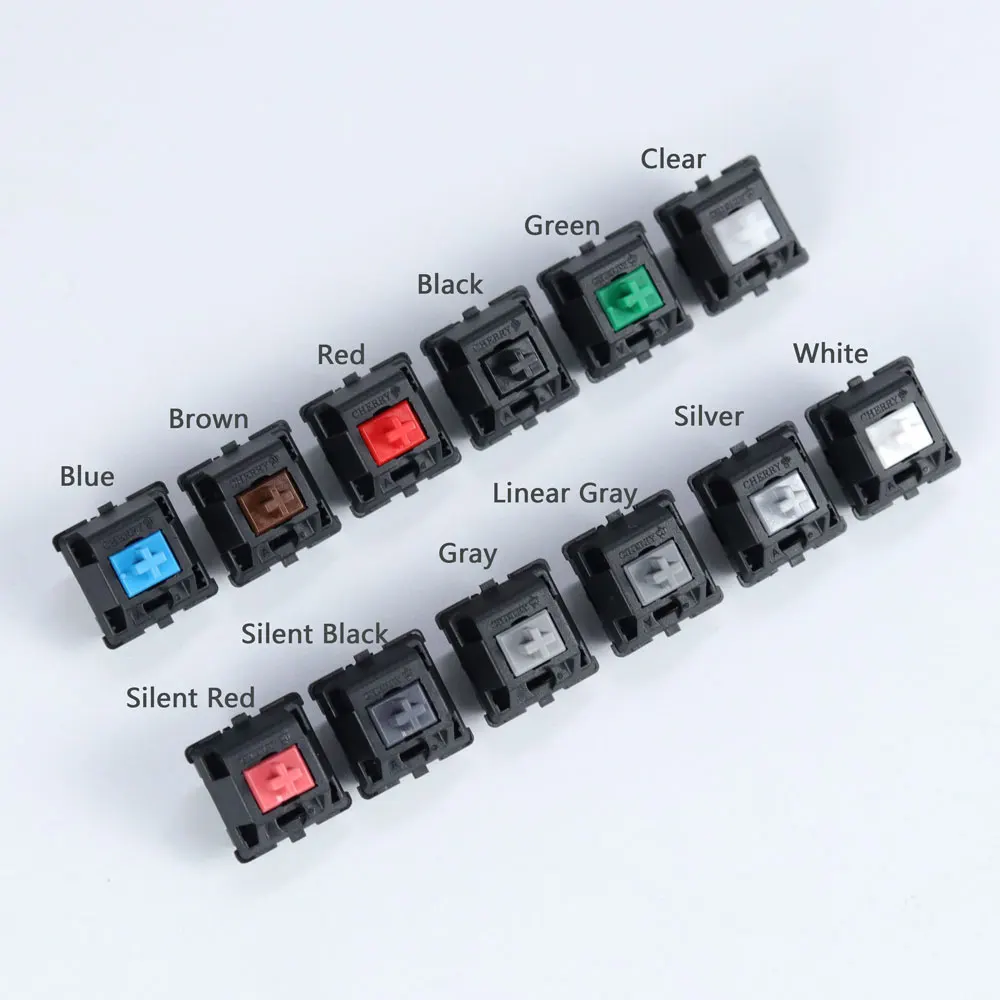Cherry MX Brown Switch Review — ThereminGoat’s Switches
Written By Benjamin Rudzinski
Oh yes, it’s finally that time.
Cherry MX Browns are, without a doubt, one of the most well-known switches in the entirety of mechanical keyboard history. With that, a lot of different opinions of them exist out there. For the most part, I’m almost certain that nothing I could say in this review is going to be anything that hasn’t already been covered somewhere by somebody at some point in time. There will be budding tech reviewers from many years ago who praised these switches as the ‘best’ among tactile switches available in the super short list of switches on the open market. There will be people who ridicule them, make memes about them, and not think a single positive thing of it. (In fact, I can think of one right now who practically does this as a full-time escapade. ) And without a doubt, there were these opinions in the past and there will be these opinions in the future.
The only thing that I can offer to you reading this right now is my take on these switches as of the current moment in the hobby. As the switch market continues to grow and expand, and companies wax and wane in their presence, there is a very real possibility that this review will not stand the test of time – like many of those that came before it. But, nonetheless, let’s have into a discussion about Cherry MX Browns.
Switch Background
Cherry MX Browns were first brought into existence in 1992 as the result of a collaboration between Kinesis, an ergonomically focused keyboard company, and Cherry. Having outfitted their ‘Advantage’ split keyboards with Cherry MX Blues prior to this date, the owner of Kinesis was a fan of the feeling of the MX Blues, but not necessarily the loud noise that they would make. According to a Kinesis employee statement in 2012, this prompted a request from the owner of Kinesis to Cherry to create a tactile, low-force switch without the ‘clicky’ sound that comes as a result of the click jacket on MX Blue switches.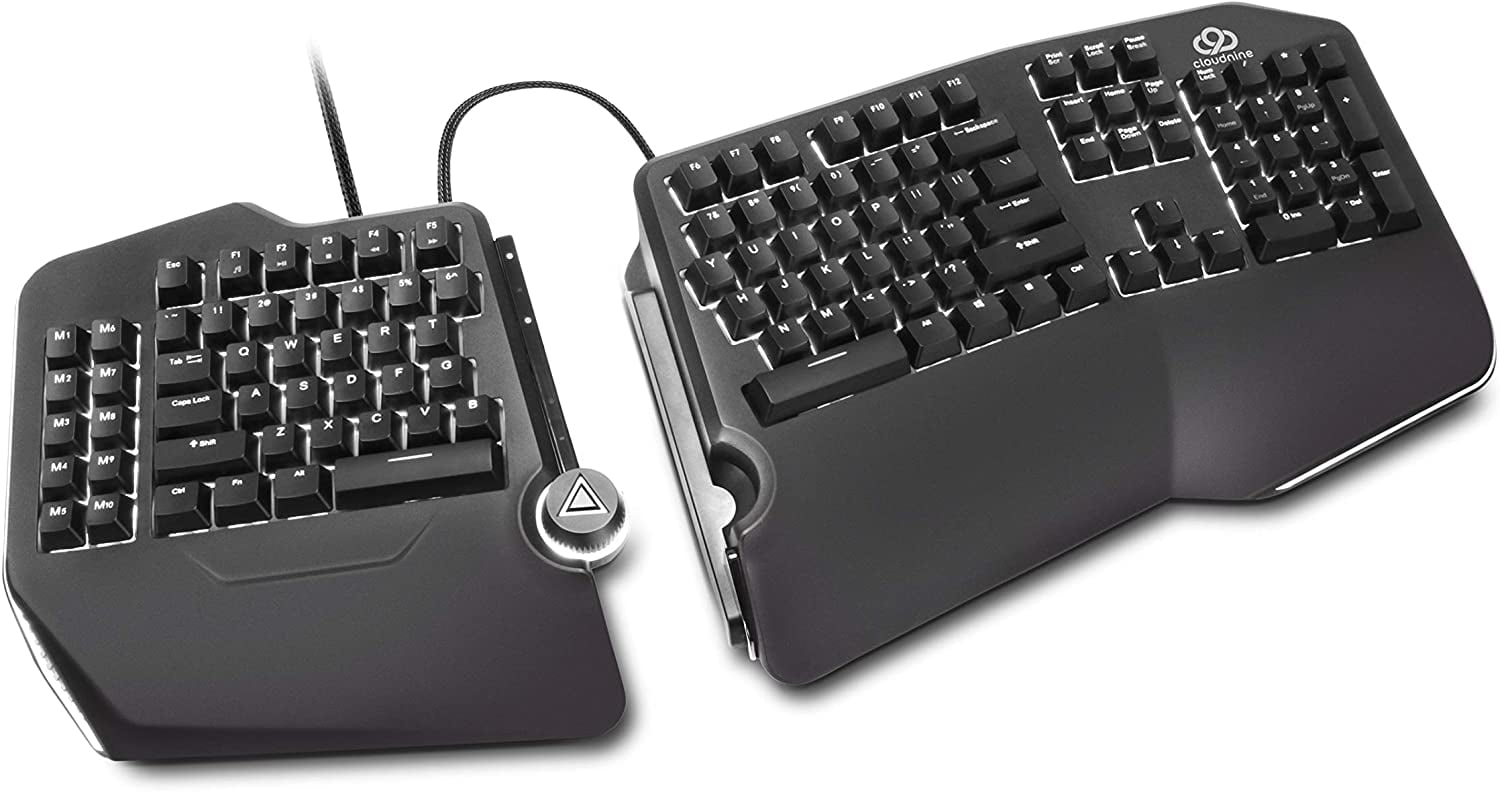
Figure 1: Kinesis Advantage 1 with Cherry MX Blue switches. [Photo from natas206 on Deskthority]
Officially dubbed as “ergo soft” switches, Cherry MX Browns were not listed in any default Cherry switch catalog for a bit of time after their inception, and were only available as a special-order item. In that meantime, though, Cherry used them as the default switch choice in their first in-house designed ergonomic split keyboard, the G80-5000 starting in 1994. After the release of the G80-5000, the MX Browns saw very little variation in usage outside of Cherry’s ergonomic board and Kinesis’ Advantage with the exception of a few point-of-sale (POS) boards until 2011. In 2011, Cherry officially released their first board containing MX Brown switches since the mid-1990s with the G80-3800.
Figure 2: Cherry G80-5000 with MX Brown switches.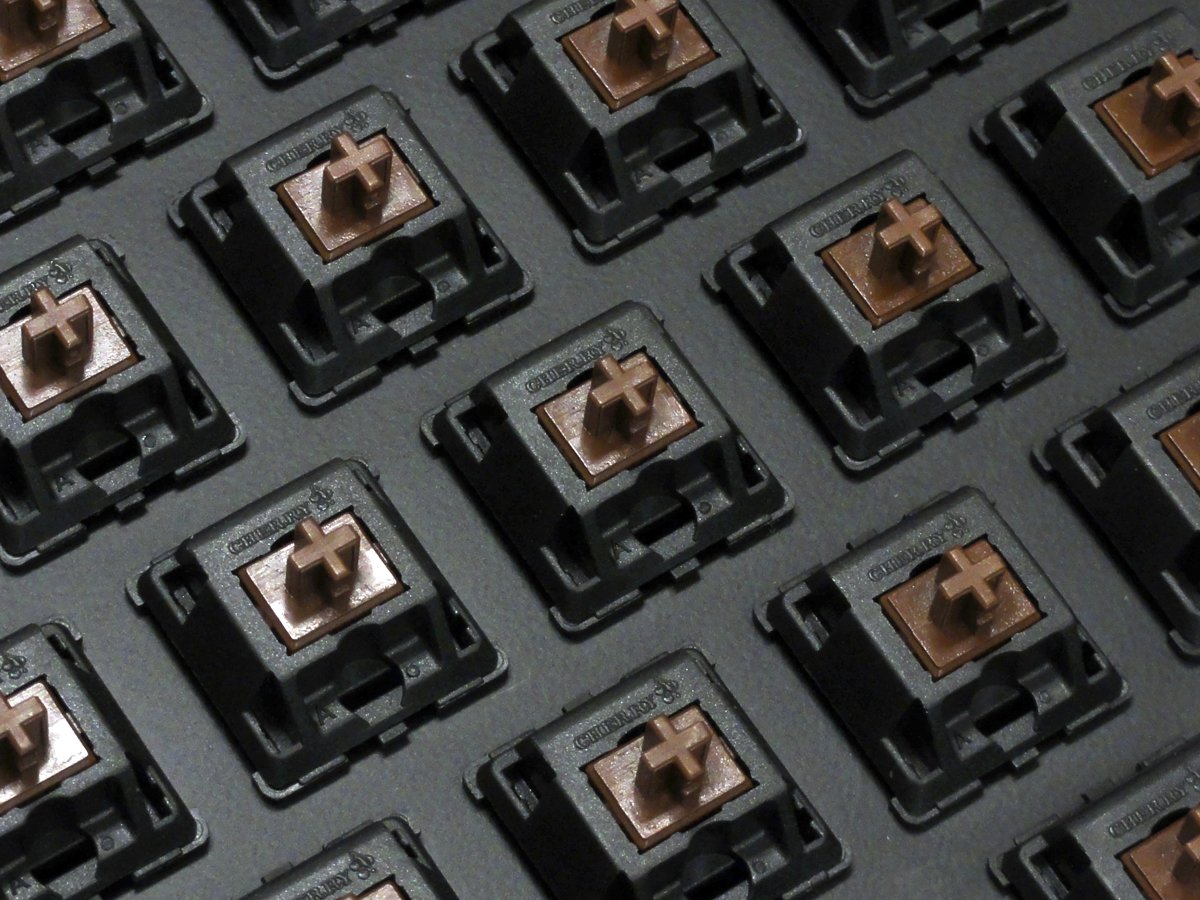
From this point in 2011, though, the entire history of Cherry MX Brown switches quite literally exploded into a million pieces. In the relatively short time between 2011 and the current date, Cherry began to fill countless OEM orders with MX Browns, making them virtually a staple option in literally any keyboard that would stock them, from POS, to corporate computers, and more prominently ‘gaming’ keyboards. To even pretend to figure out the specific, board by board history of Cherry MX Browns past this point would literally be a full-time job for the rest of my life if such a thing were even to be possible. However, since I am unable to go that much further into the history of MX Browns, lets differentiate from other reviews and to talk a bit about some technical details of Cherry MX switches as well as the known variations in Cherry MX Brown switches that exist out there.
Figure 3: Picture of the 5 variants of Brown colored switches from Cherry.
Before actually launching into a breakdown of what the Cherry MX Brown switches are in the photo above, I want to point out that these are (surprisingly) not from my collection. Instead, this photo (as well as the detailed part numbers) come as a result of one tireless collector by the name of UncleFan. While I have a much more vested interest in modern switches and offshoots of the Cherry MX design, UncleFan has the world’s largest collection of Cherry switches with over 175 unique Cherry switches, all painstakingly catalogued by part code. Needless to say, I’m beyond envious of his collection as it is incredibly well researched, catalogued, and stocked with switches that I could only dream of owning one day. Props to you UncleFan – its is an incredible collection.
Figure 4: An absolutely, insanely, and incredibly well researched Cherry switch collection from UncleFan.
Keeping true to my word, as well as to fully appreciate the labels that UncleFan has figured out for switches in his collection, I think it is worth discussing how exactly Cherry generates these part codes for switches in the first place.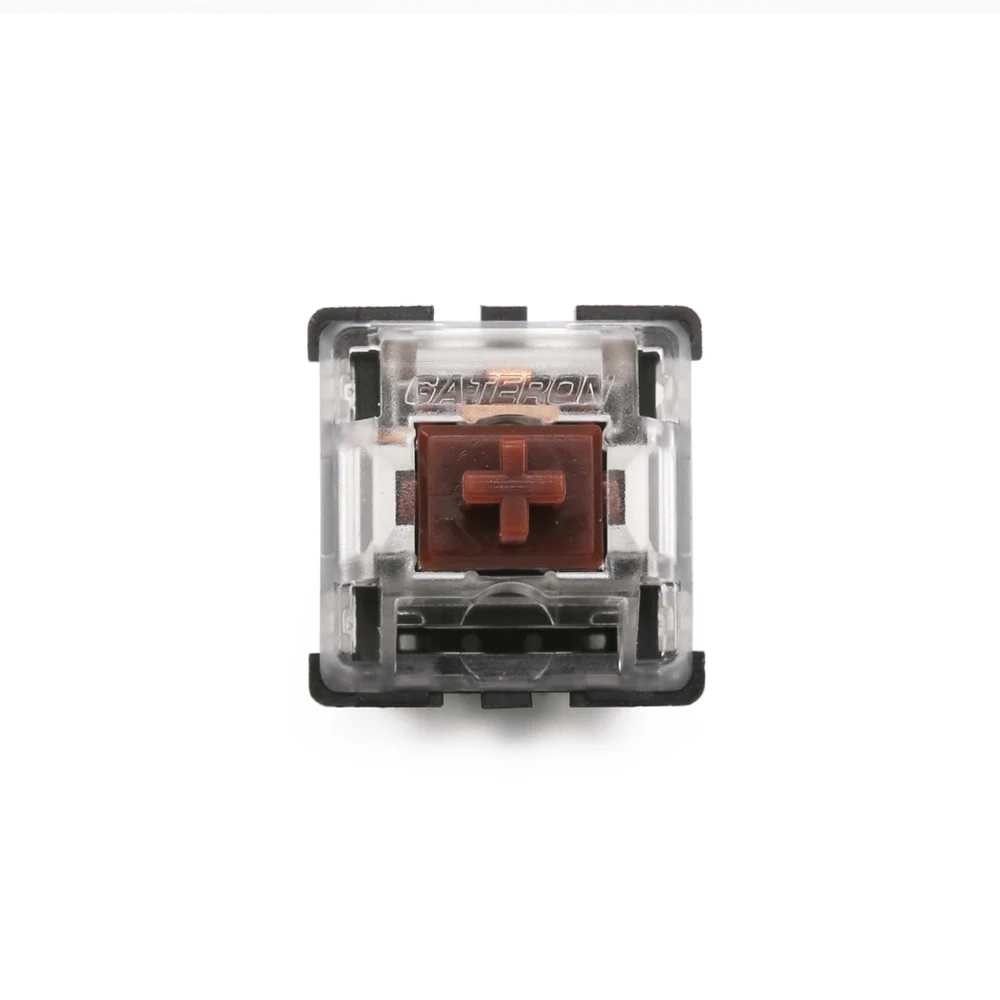
Red/#1 – MX simply refers to Cherry’s internal part coding for ‘Keyswitch Module’ from the ‘MX Family’ design. (Other designs like MY, ML, etc. exist if you were unaware of these)
Orange/#2 – This category is simply listed as ‘Material’, ‘Silenced Slider’, and ‘Special’ as the three respective options without much of an explanation as to what these things mean. Beyond all doubt, the vast majority of you will have only used MX switches with a ‘1’ for this category.
Yellow/#3 – This is a further classification of ‘SPST NO’ and ‘Special’, with SPST NO simply referring to switches that have a single stem, single activation, and are normally ‘open’ or not producing a signal.
Green/#4 – These are the classifications that correspond to what particular color and style of switch that is being used.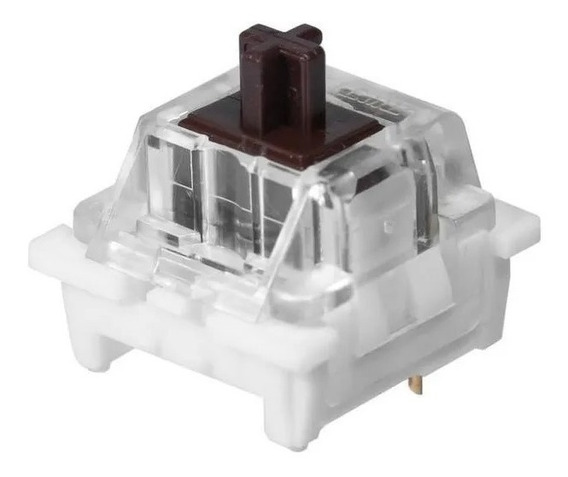
Blue/#5 – This code number corresponds to extra integrated components. While ‘N’ refers to none, ‘R’, ‘G’, and ‘Y’ correspond to different colored LEDs and ‘D’ and ‘J’ refer to diodes and jumper wires, respectively.
Purple/#6 – This last category is used to designated what color of the housings are either Black (N/W) or Clear (A/B) as well as whether or not these have PCB mount pins.
Figure 5: Yeah, I posted it again because I didn’t feel like scrolling either.
MX1A-G1DW
Listed as ‘Pale Brown’ in color in his collection, these likely belong to the older boards that the Cherry MX Browns were originally equipped in as the ‘D’ designation in the second to last letter of this part code corresponds to a diode being included within the switch.
MX3A-L1NN
Coming in as your ‘stereotypical’ MX Brown switch, these come in the classic, black Cherry nylon housings and have no PCB mount legs.
MX3A-L1NA
The only difference between this switch and the one before it is that it comes in Cherry’s RGB housings rather than the Black housing. This also does not have PCB mount legs.
“Hirose Cherry MX Brown” and “Hirose Cherry MX Reddish Brown”
These are certainly the odd ones out here. If you’re familiar with Cherry Hirose switches, you’ll note immediately that these come from boards that appear much older than the 1992 debut of Cherry Brown switches. That is because these are technically not Cherry MX Browns in name nor in style. In fact, these are extremely rare variants of Cherry Hirose switches that are commonly seen in Orange or White, and have only been photographed in this Brown variant twice as far as I am aware.
In addition to the Cherry MX Brown switches that exist out there, many of you who are reading this have likely encountered Brown switches that have been created by other companies since the expiry of the Cherry MX patent around 2014.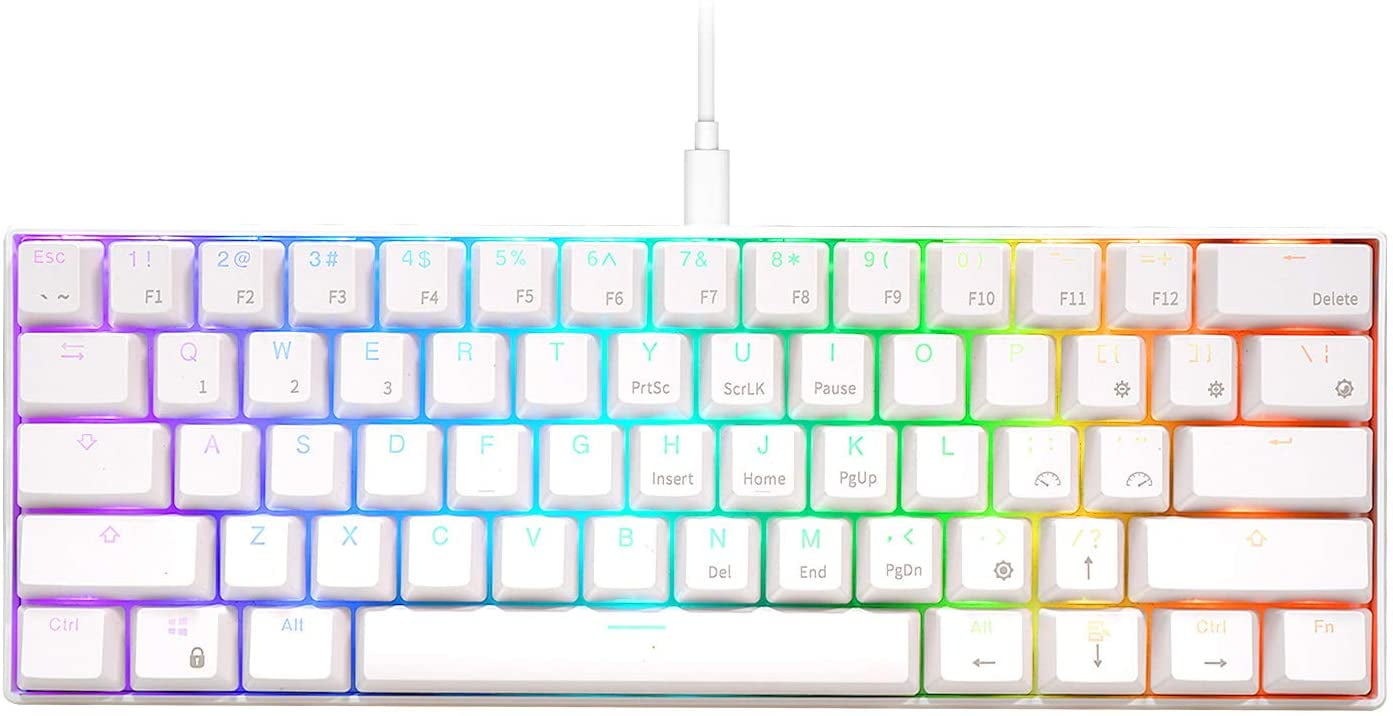
Gateron (6+ Different Variants)
TTC (3 Different Variants)
Kailh (6+ Different Variants)
NewGiant
Huano
Longhua (Which is technically made by Kailh)
Content
BSUN
Zorro
Greetech
Xinda
Kaicheng
Outemu (4+ Different Variants)
Noppoo
KBTalk
Orange
Cherry MX Brown Switch Performance
Note: As mentioned above, this review will be done on black housing, MX3A-L1NN switch.
Appearance
Unlike more modern switch reviews that I do, Cherry MX Browns are fairly short, sweet, and to the point when it comes to appearance. These feature all black, nylon housings with a brown, ‘tea’ colored stem and silver colored springs that are most likely made of steel. Pictured in Figure 6, below, you’ll note the tactile stem legs on the Cherry MX brown are fairly subtle in their bump as well as the only two mold marking circles on the stem, which are located on the front side of the Cherry MX Brown stem.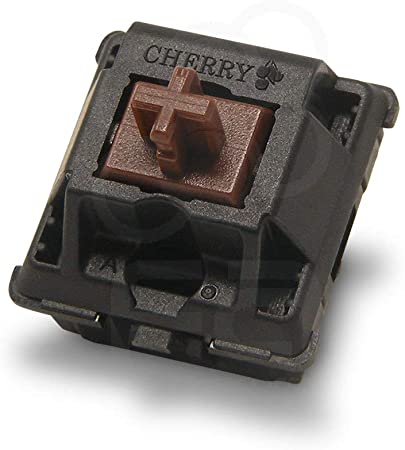
Figure 6: Cherry MX Brown side profile.
The only other interesting point of note regarding the appearance of these switches are the mold markings of the bottom of the bottom housing. While I sincerely doubt that we are at any risk of Cherry switches being one to one replicated by JWK or any other Chinese manufacturer, I am still interested in the mold markings in much the same fashion as I am with newer releases. In particular, the mold marking that stands out the most relative to other, newer releases is the sideways printed set of three numbers corresponding, I assume, to either mold or production line numbers. As well in Figure 7, below, a fairly standard one letter mold code can be found between the LED pin holes in the bottom right-hand side, which is common among the recent molds I’ve photographed. Finally, there are two large, smooth circles where PCB legs would be implemented.
Figure 7: Cherry MX Brown bottom housing mold markings.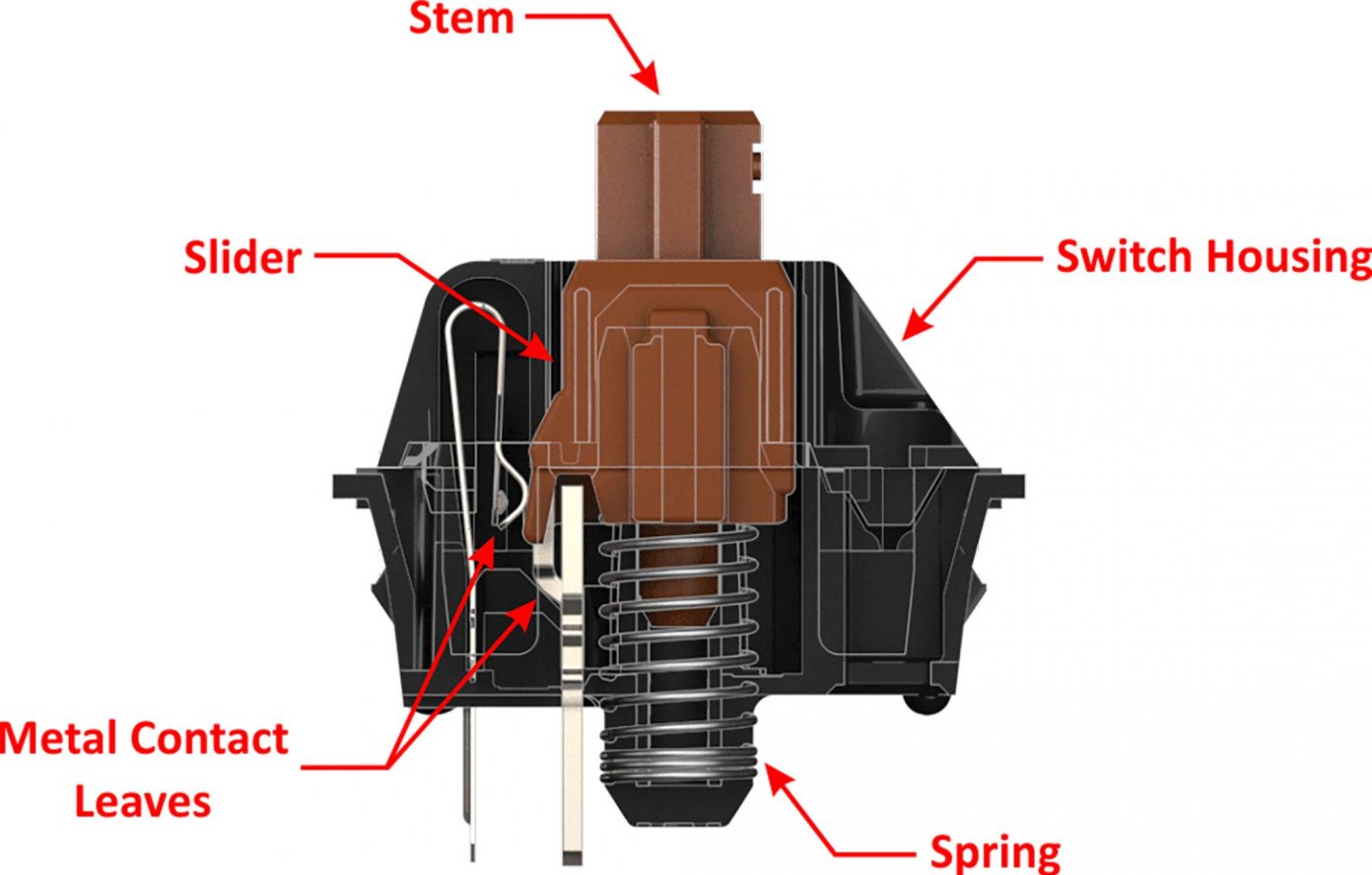
Push Feel
The push feel of Cherry MX Browns is the most consistently meme-d upon part of the “Cherry MX Brown experience,” and to be entirely honest I don’t think that it is that deserved. While the switches definitely aren’t exactly the finger-breaking tactility that people deeply entrenched in this hobby seem to enjoy en masse, these switches actually have a fairly subtle, light end tactile bump that is noticeable without being overpowering. Centered in nearly the middle of the stroke both by feel and by the numerous force curves that exist out there for them, the downstroke and upstroke both provide a light and just the tiniest bit snappy tactile bump experience.
While I’ve now thoroughly explained why I think the “ArE ThEy TaCtIlE oR LiNeAr” memes are a bit overblown and not indicative of the reality of these switches, I think the rest of the commonplace ideas about Cherry switches hold true here. The one that I have from my collection as well as the few that I have lying around in spares have a noticeably harsh, gravely scratchiness that leads many people to “break in” linear Cherry switches such as MX Blacks.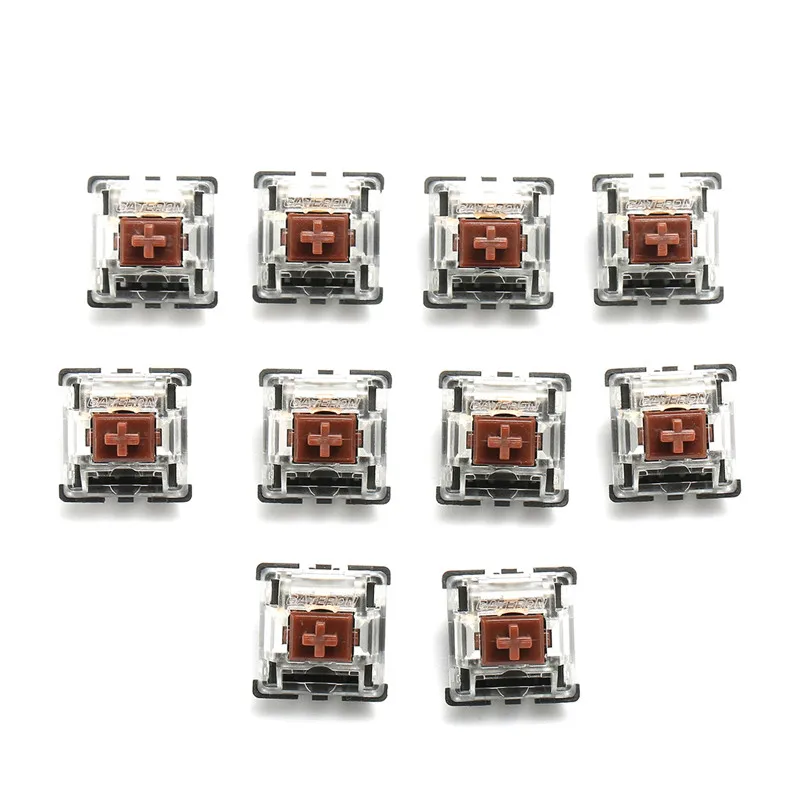
Keeping the above-mentioned notes about push feel in mind, I know for a fact that these switches can be improved with aftermarket modifications. Cherry is one of the few brands where I genuinely feel that the greater time you put into modifying the switches, such as a skillful application of lube, breaking them in, spring swapping, etc., the greater reward you can get from them. In fact, I’ve felt Cherry MX Brown switches in the past that have been modified to such an extent as to mitigate if not altogether eliminate the list of weak points stated above.
Sound
In stock form, the sound of these switches is… not great. The gravel like scratch in the push feel definitely comes through in the form of an equally as gravelly scratch sound that would make even DMX a bit shy.
The one shining point in these switches in terms of sound is the same brilliant point across all black housing Cherry switches: the muted, deep, and solid sounding bottoming out and topping out. In addition to a noticeably thicker top and bottom housing by inspection, the nearly pure nylon composition of these housings makes for an incredibly sounding set of collisions in all Cherry switches, as well as the MX Browns.
Wobble
Given the fact that Cherry MX switches have been produced in such astronomically large quantities, it’s really hard to gauge the wobble of the switches on as small of a subset of switches as I have in hand. When you are reading this and thinking of your own MX Browns you’ve tried out before, know that your mileage has almost certainly varied compared to mine.
In the switches that I had for testing, there was some top housing wobble in the E/W direction, but not substantially enough to affect performance. In addition to being able to be fixed by the use of films, I believe this could easily be dealt with by using a plate with tighter tolerances. As well, there is a noticeable amount of stem wobble in both the N/S and E/W direction, with even the greater magnitude E/W direction wobble not being among the worst that I’ve seen in reviews thus far. Overall, they’re not nearly as bad for wobble as I or many people would have memed them out to be, but they aren’t spectacular either.
Comparison Notes to Other Notable Tactile Switches
Note – These are not aimed at being comprehensive comparisons between all factors of these switches as this would simply be too long for this writeup. These are little notes of interest I generated when comparing these pieces to the Cherry MX Brown side by side.
Figure 8: Switches for comparison.
If you would like to learn more about these switches, I’ve already completed reviews or scorecards for some of them. If the names below are highlighted in a grey color, click them to be taken to my other content or reviews on them!
Pewter
– The first, most noticeable difference between these two switches is that the Pewters are by far significantly less tactile and have a much lighter bump than the Cherry MX Browns.
– As well, being that these are factory lubed switches produced at JWK, the Pewter switches are significantly more smooth and have noticeably less wobble.
– The tactile bump of the Pewters, while fairly centrally located relative to other tactile switch offerings currently, is still a bit earlier in the stroke than the Cherry MX Browns.
Lilac
– The Lilacs have a noticeably more snappy tactile bump than the MX Browns in terms of push feel and especially so in terms of sound.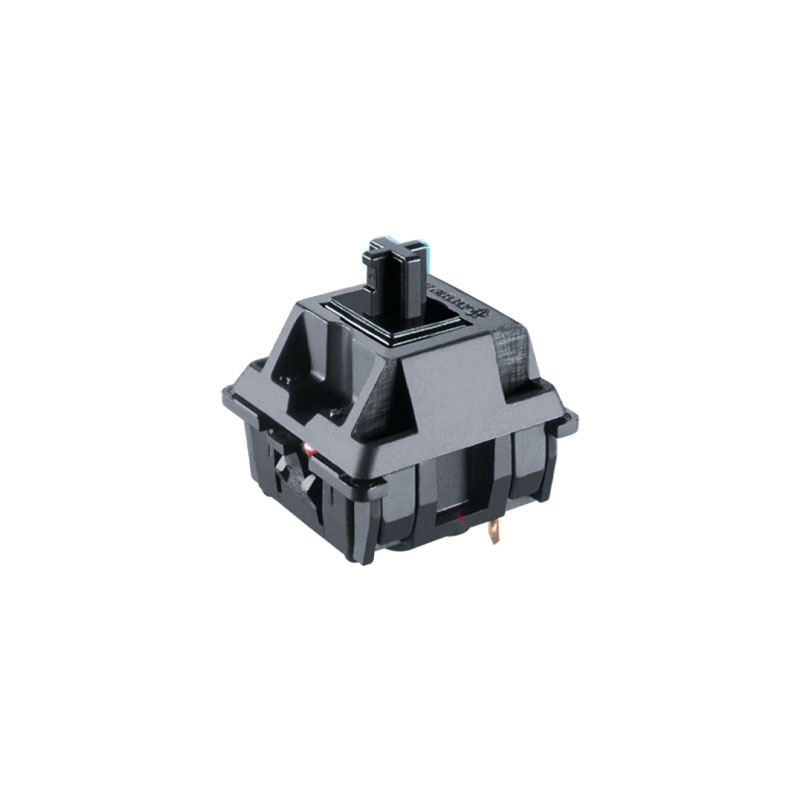
– While the Lilacs aren’t particularly smooth on their own, and have a slight bit of scratch feeling in them, they are noticeably less scratchy than the Cherry MX Browns.
– As well, the Lilacs had significantly less stem wobble in both directions as compared to the MX Browns.
Kailh Polia
– Polias have both noticeably longer and stronger tactile bumps than the relatively short and light Cherry MX Brown. With that in mind, the tactile bump of the Polia switches starts significantly earlier in the downstroke than the MX Browns.
– With respect to sound, there is a bit of a strange note to make here. While the tactile bump of the Polias sound more full bodied, deeper, and firm, the Cherry MX Brown housings and the collisions with those housings produce the deeper and more firm sound out of the two of these switches.
– Both the MX Browns and Polias have a comparable amount of stem wobble, with the Polias having a more fairly balanced N/S and E/W magnitude wobble than compared to the MX Brown’s E/W dominant stem wobble.
Koala
– While located in a different spot in the downstroke and having a different strength in tactility, the Koala’s tactile bump feels significantly more ‘singular’ than the MX Browns which feels a bit less distinct and coherent.
– Overall, there is significantly less stem wobble and top housing wobble in the Koala switches than in the MX Browns.
– Of all of the tactile switches in this list, I would say that these definitely appear to have the most similar scratch feeling as the MX Browns, though it is significantly lesser in magnitude.
Kailh Box Royal
– The Box Royals have both a significantly stronger tactile bump and a significantly more rapid fall off in tactility as compared to the MX Brown switches. While the MX Browns are definitely smaller in terms of overall size of bump, they feel more like driving over a speed bump than driving off of a cliff that is the tactility of Box Royals.
– While the Box Royals certainly give the Koalas a run for their money in terms of comparable scratchiness as compared to the MX Browns, it is noticeably a bit more fine and less ‘gravelly’ than the MX Browns.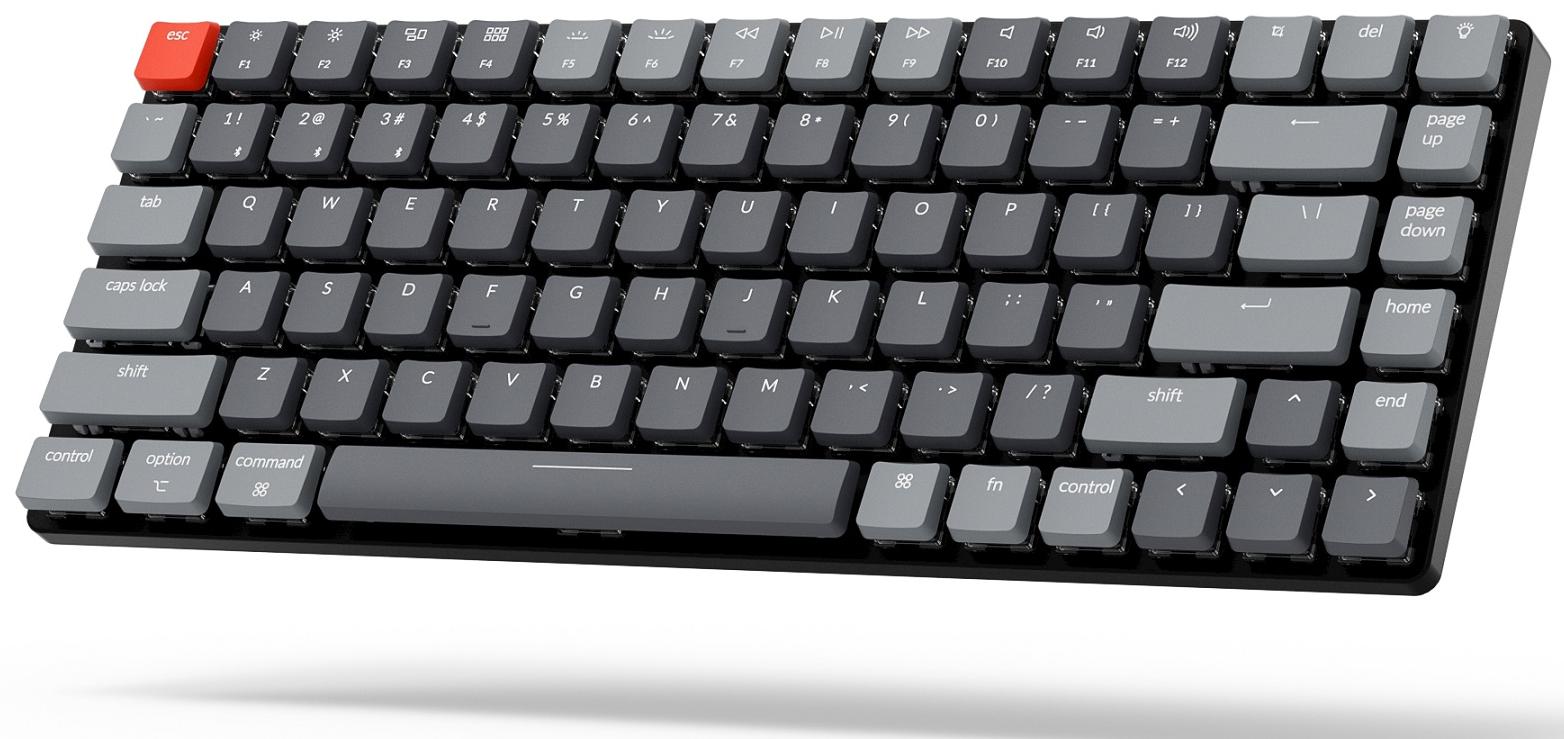
– Overall, the bottoming and topping out sounds of the Box Royal are much more thin and airy sounding than the firm, solid sound of the Cherry nylon housings.
Gateron Kangaroo Ink
– The Gateron Kangaroo Inks have a noticeably more snappy tactile bump than the MX Browns both in terms of sound as well as tactile feeling.
– As well, much like with all of the other comparisons on this list, the Cherry MX Browns still completely beat out the Kangaroo Inks in terms of solidness and deepness of bottoming out sound and feel.
– There is significantly less stem wobble in both the N/S and E/W directions of the Kangaroo Inks as compared to the MX Browns.
Bonus Round
It’s not everyday that you review a classic like MX Browns, so here’s a few more comparisons to enjoy:
Gateron KS3 Brown
– The Gateron KS3 Brown definitely has more of an overpowering scratch to its stroke than the Cherry MX Brown, but its also significantly more consistent across the stroke.
– The Cherry MX Browns are much worse for stem wobble in both N/S and E/W directions as compared to the Gateron Browns.
– The Gateron Brown tactile bump is just the smallest fraction a bit softer and lighter than that of the Cherry MX Brown.
Kailh Brown
– The Kailh Browns feel a bit more heavy in terms of bottoming out spring weight as well as the tactile bump. This gives it an every so slightly stronger, and more crisp tactile event than that of the Cherry MX Browns.
– The Kailh Browns also have a tactile bump that is noticeably higher up in the push feel as compared to the Cherry MX Browns.
– The Cherry MX Browns still edge out the Kailh Browns in terms of depth of sound for topping and bottoming out, though it isn’t by much.
Outemu Brown (OEM White Bottom)
– The Outemu Browns have an ever so slightly greater tactile bump than the Cherry MX Browns, but happens to match the location in the stroke nearly exactly to that of the MX Browns.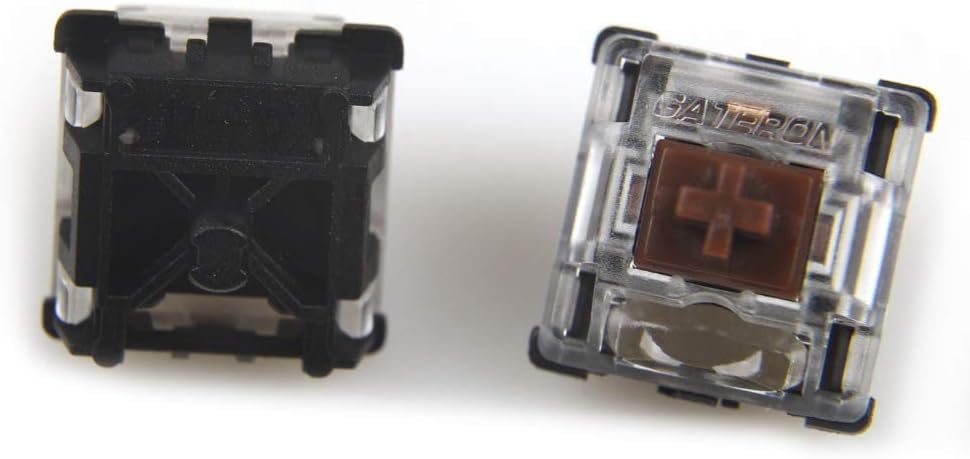
– The Outemu Browns also have noticeably louder spring or leaf ping that is noticeable at all typing speeds, rather than sequestered to higher typing speeds like in Cherry MX Browns.
– Again, much like with Kailh Browns, Cherry MX Browns have noticeably deeper topping and bottoming out sounds than that of the Outemu Browns.
TTC Gold Brown V2
– Of all of the switches on this list (as well as the normal list above this), these are the most thin and flimsy sounding and feeling switches out of all of them.
– I would also go as far as to say that while they have a more consistent scratch feeling than that of the MX Browns, it is overall more noticeable than in the MX Browns.
– Surprisingly, though, the TTC Gold Brown V2s are on par, if not a tiny bit better with respect to stem wobble in both directions than the Cherry MX Browns.
Scores and Statistics
Note – These scores are not necessarily completely indicative of the nuanced review above.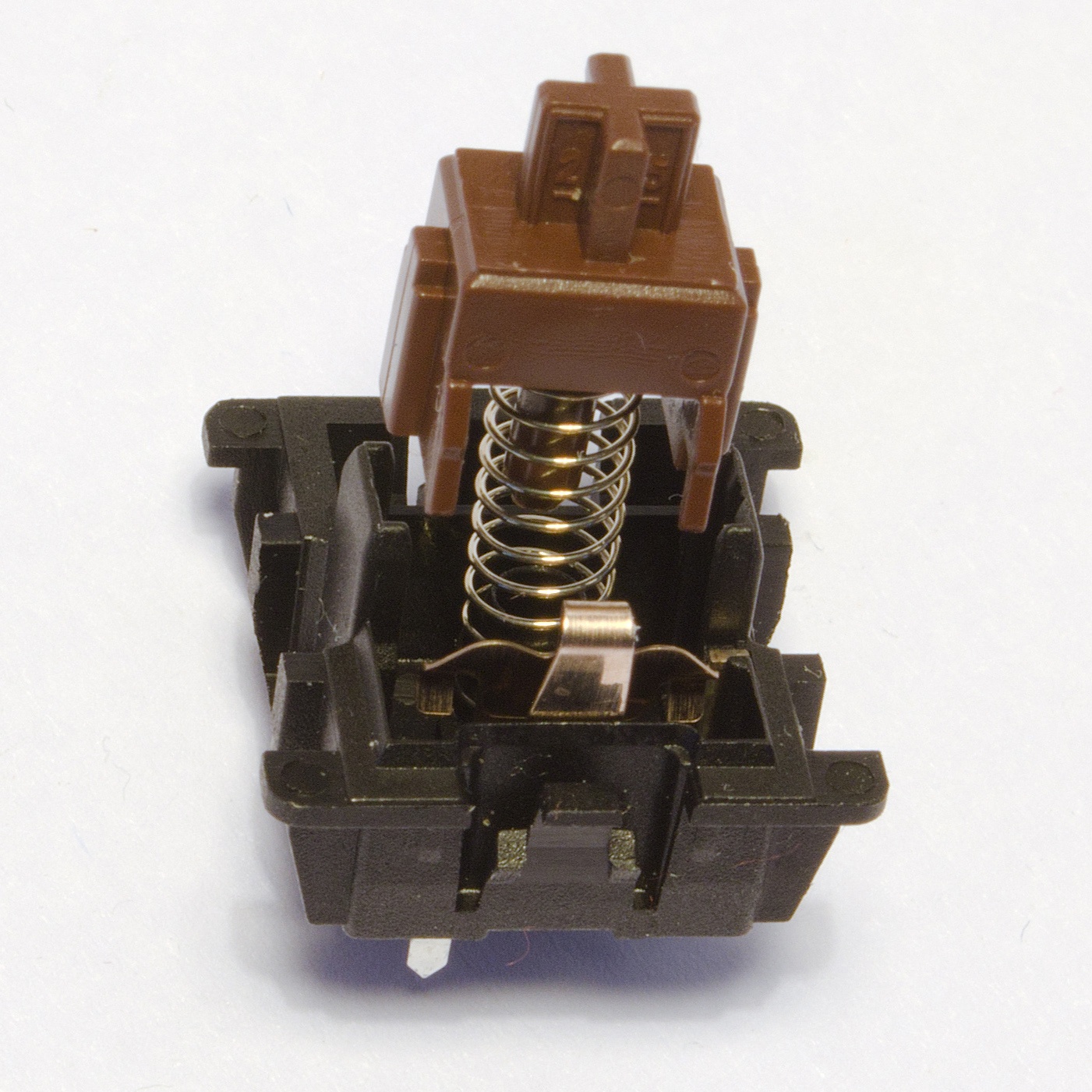
Push Feel
Stock Cherry switches, in general, don’t tend to be all that great relatively speaking and MX Browns do it no favors. Between the aggressive scratch, ping-like feeling due to the leaf, and non-cohesive bump, it’s hard to give this a much higher score. The biggest savior of these switches, by far, is it’s iconic low-tactility bump and the rock-solid bottoming/topping out.
Wobble
While I stated in the long-form review that wobble is highly variable across the years of MX Brown production, the average switch I’ve tried has a slight bit of E/W top housing wobble and noticeable stem wobble. The stem wobble also has a stronger E/W wobble than N/S.
Sound
The sound, overall, really isn’t great in this switch and it is very much a mirror of the push feel.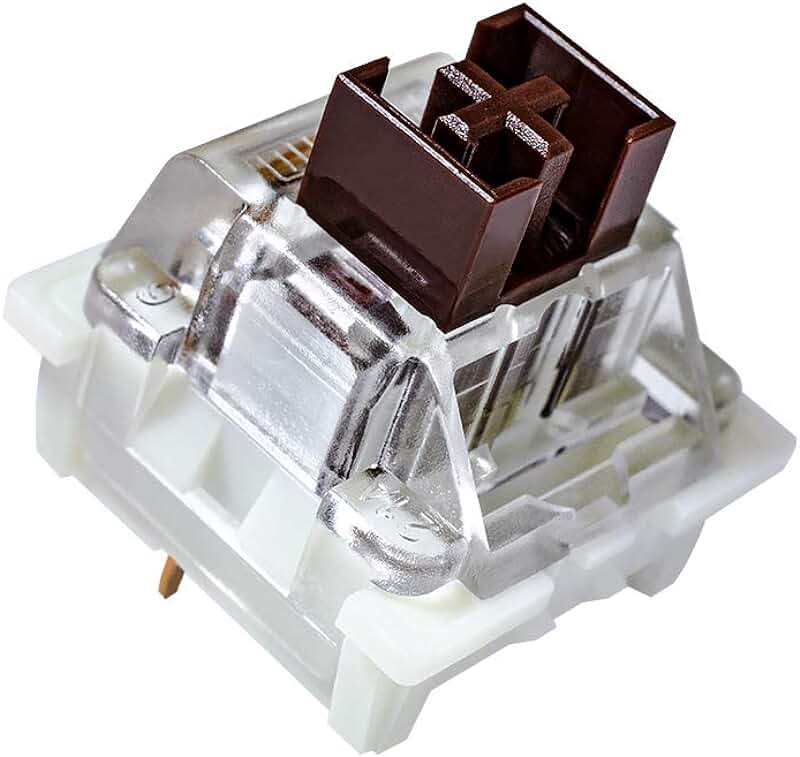
Context
Say what you want about this score. These have been insanely prevalent in this community since its inception, they’re widely available, cheap, and the entry point for so many enthusiasts into this hobby. While they could be a bit better about quality, there’s no arguing that these are contextually one of the most important switches of the modern era.
Other
It’s really hard to really quantify the value of these switches or even their performance relative to other switches given how much of a ‘baseline’ they’ve been not only for myself but for everyone for some time. While they do provide good memes in and of themselves, I truly think MX Browns deserve more recognition than they get when viewed as a whole.
Statistics
If you are looking at this statistics section for the first time and wondering where the hell are the other 67 switches that I’ve ranked are, or what ‘hard’ versus ‘soft’ ranks refer to specifically, I’d encourage you to head on over to my GitHub linked in the table above or at the links in the top right hand of this website to check out my database of scorecards as well as the ‘Composite Score Sheet’ which has a full listing of the rankings for each and every switch I’ve ranked thus far.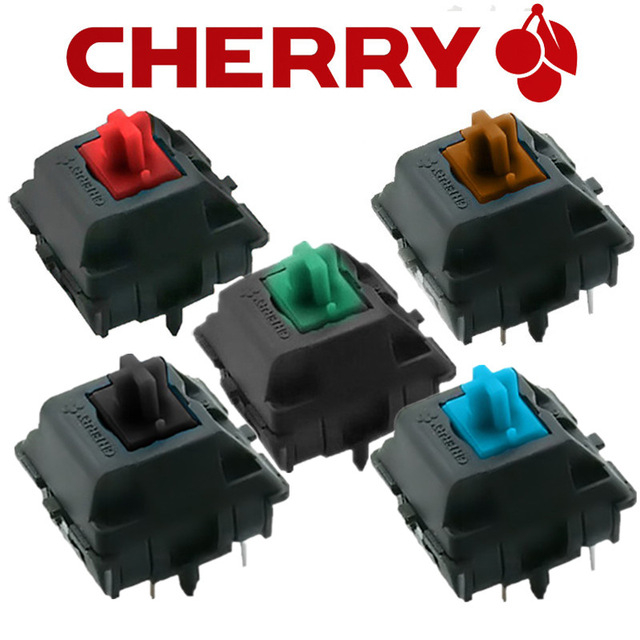
Final Conclusions
As I alluded to in the introduction to this review, to the many of you who are my regular readers, this doesn’t have much information you’ve not already heard before. To that end, though, I didn’t just do this review “for the memes” but rather to more deeply explore something that has been reviewed or thought about by quite literally everybody who has brushed with mechanical keyboards before. In some sense, doing this review is a lot like my Gateron Yellow switch review in that it gives a litmus test for new readers to gauge my reviews directly to that of other Gateron Yellow or MX Brown switch reviews out there to determine how I stand in terms of reviewers. On another hand, though, one could argue that this review was long overdue on my end and it’s great timing to start this review off as my first one of my second year of this website.
Having actually stepped up to the task, though, and reviewing Cherry MX Browns, I can say that I’m not entirely surprised by my findings.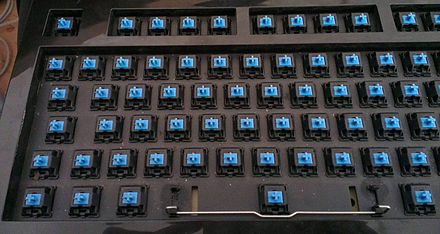
So, to put the questions so many beginners have asked of me before to rest for now: No, I do not think these are “great” switches. That doesn’t mean I think that they are bad either. These are a good, subtle, and widely available introductory switch into the hobby that may end up being the switch that you love for the rest of your time in the hobby.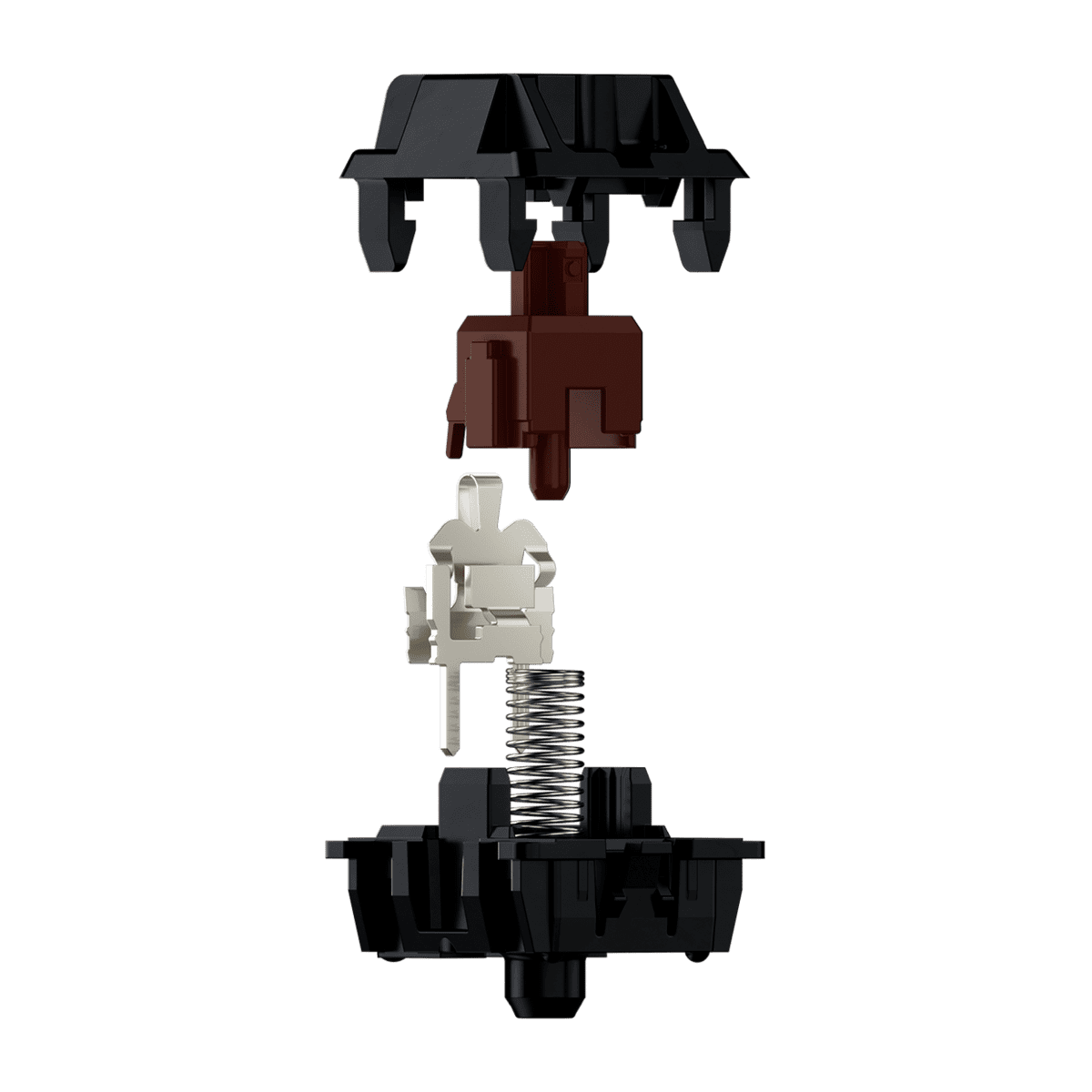
Sponsors/Affiliates
Interested in some of the switches that I’ve compared to MX Browns here but don’t want to buy 90 packs just to try them out? Follow my affiliate link here to Mechbox to try out their singles and support these reviews
Further Reading
UncleFan’s Cherry Collection Latest Update
Wayback
UncleFan’s page showing Cherry MX Hirose Browns
Wayback
Kinesis Employee Statement about origin of MX Browns
Wayback
Deskthority’s Cherry MX Switch Page
Wayback
Cherry’s MX Brown Page
Wayback
Worst Review of MX Browns to Date
Benjamin Rudzinski
Gateron mechanical switch guide
Gateron Mechanical Switch Guide
Many of you may want to enhance your workspace productivity by customizing your keyboard typing experience and replace that dumb rubber keyboard.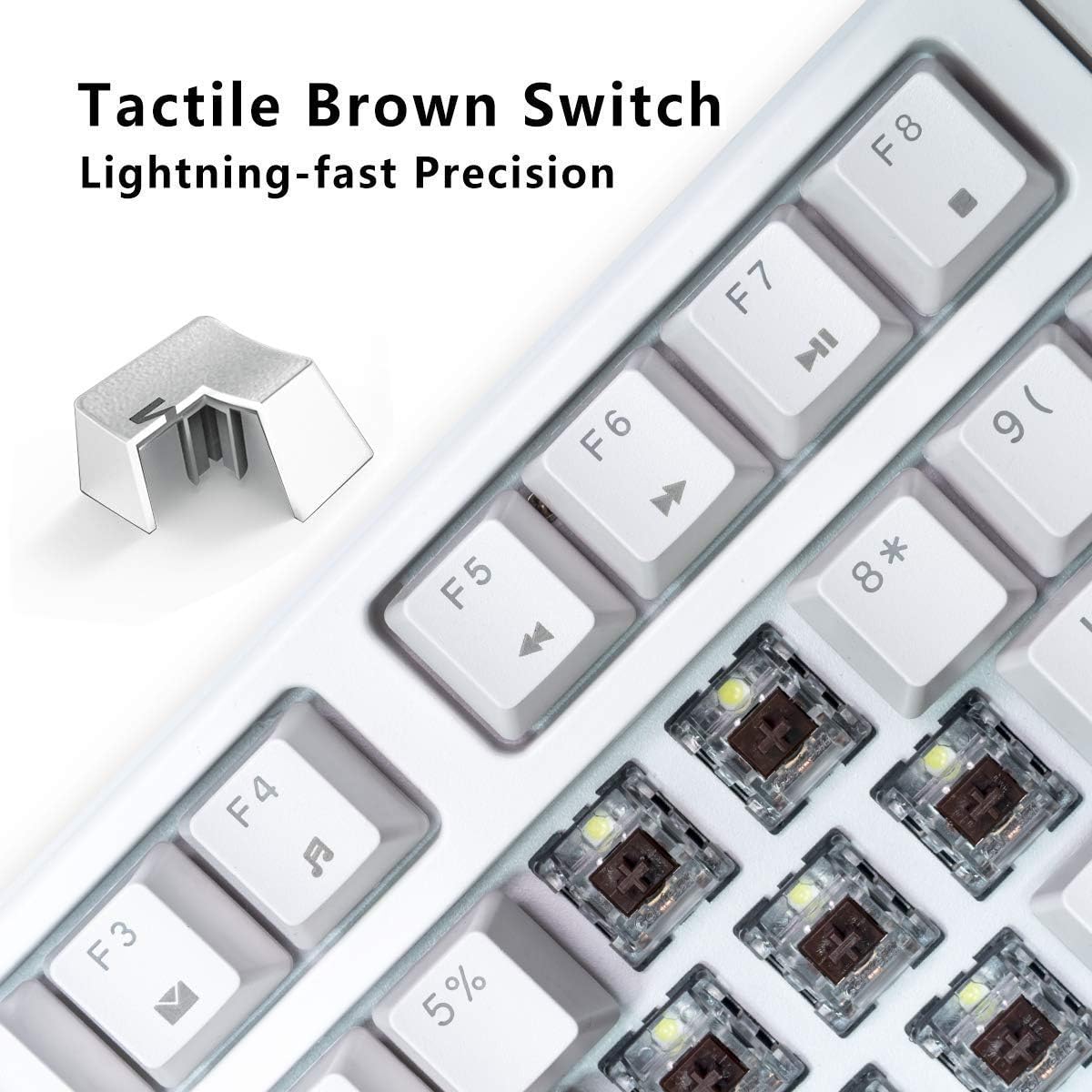
Gateron switches are currently recognized as the smoothest mass-produced switches you can buy. The silky smoothness is the main characteristic of the Gateron switches, it is even smoother than the Cherry switches. You can’t miss the Gateron switch if you like mechanical switches and enjoy a smooth typing feeling.
But there are many mass-produced Gateron switches, so the question is which one to choose. Today, we’re giving you a detailed introduction to the various Gateron switches, so you can choose the most suitable one for you.
For Gateron mass-produced switches, we recommend the KS-9 series because this series is adapted to the hot-swappable mechanical keyboard, easy for anyone to install and change, and also quite affordable.
Click here to the purchase link of Gateron switches.
Whether you prefer linear, clicky or something in between, we’ve got you covered.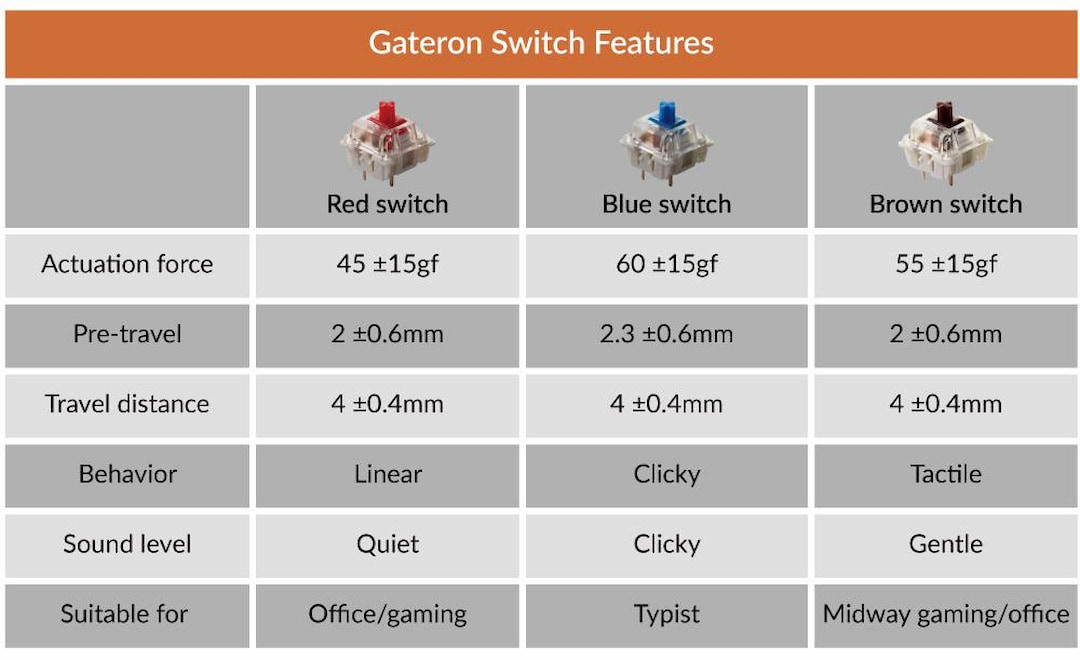
With 10 years of switch manufacturing experience, the Gateron MX style SMD-LED compatible switch is known for its reliability with a 50 million keystroke lifespan for each switch.
That’s why we have incorporated Gateron switches throughout our product line and have been recognized by lots of major influencers and media including Marques Brownlee, The Next Web, Cult of Mac and CNN etc.
The Detailed Comparison Of Each Switches
To create a comprehensive comparison, we reviewed the switches based on 3 main categories: the pressing feeling, needs of the scene, and of course the sound on the environment.
Gateron Red Switch
Gateron red is the most commonly used Gateron switch because it is a linear switch, making the typing sound quieter. The pressure is more moderate, light, and prolonged periods of typing will not feel tired. They are suitable for a variety of scenarios and also suitable for most people to use.
Actuation force: 45 g
Travel distance: 2 mm
Structure: linear
Pressing feeling: vertical, light pressing force, soft rebound
Scene: game, typing, daily work (all scenes)
Sound: quiet
Gateron Blue Switch
Gateron Blue has a unique clicky touch feel and a louder sound. It still has the characteristics of the Gateron Switch and is smooth with a tactile feedback. This structure can let you type for a long periods and not get tired.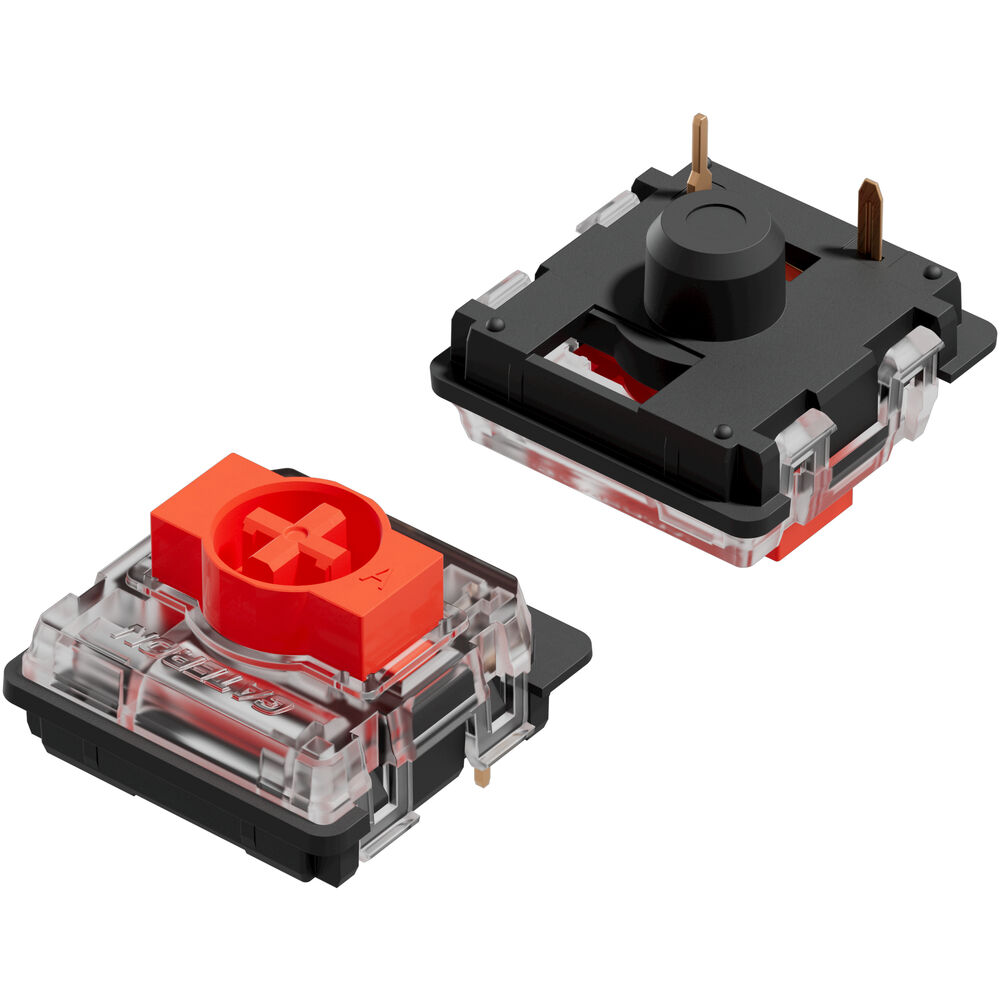
Actuation force: 60 g
Travel distance: 2 mm
Structure: clicky
Pressing feeling: clicky, moderate pressing force, clear rebound
Scene: game, typing
Sound: clicky
Gateron Brown Switch
Gateron’s brown switch has the characteristics of both the red and blue switches. The vertical press still feels smooth, but also has the feeling of a bump. The sound is relatively quiet and will not disturb the surrounding environment.
Actuation force: 55 g
Travel distance: 2 mm
Structure: tactile
Pressing feeling: bump, moderate pressing force, clear rebound
Scene: games, typing, daily work (all scenes)
Sound: medium
Gateron White Switch
The white switch has the lightest actuation force amongst the linear switches.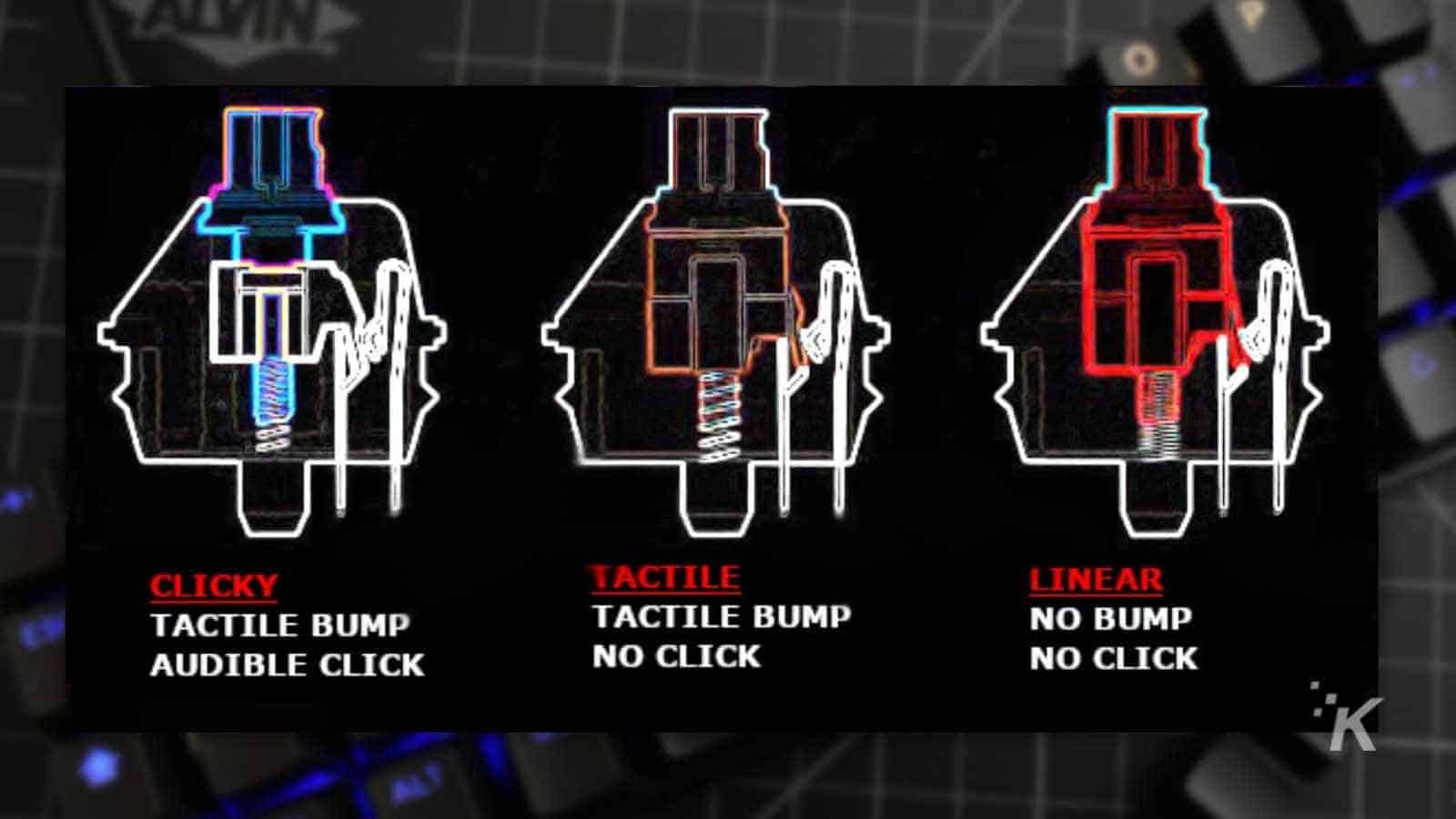
Actuation force: 35 g
Travel distance: 2 mm
Structure: linear
Pressing feeling: vertical, very light pressing force, soft rebound
Scenario: typing, daily work (all scenes)
Sound: quite
Gateron Yellow Switch
Gateron yellow switches have been very popular recently. The design of the Gateron yellow switch is the same as the red switch, but the departure strength is 5g bigger, which seems small but does offer a difference in feeling. The feedback of the yellow switch is more rigid, but it doesn’t need heavy force to be triggered.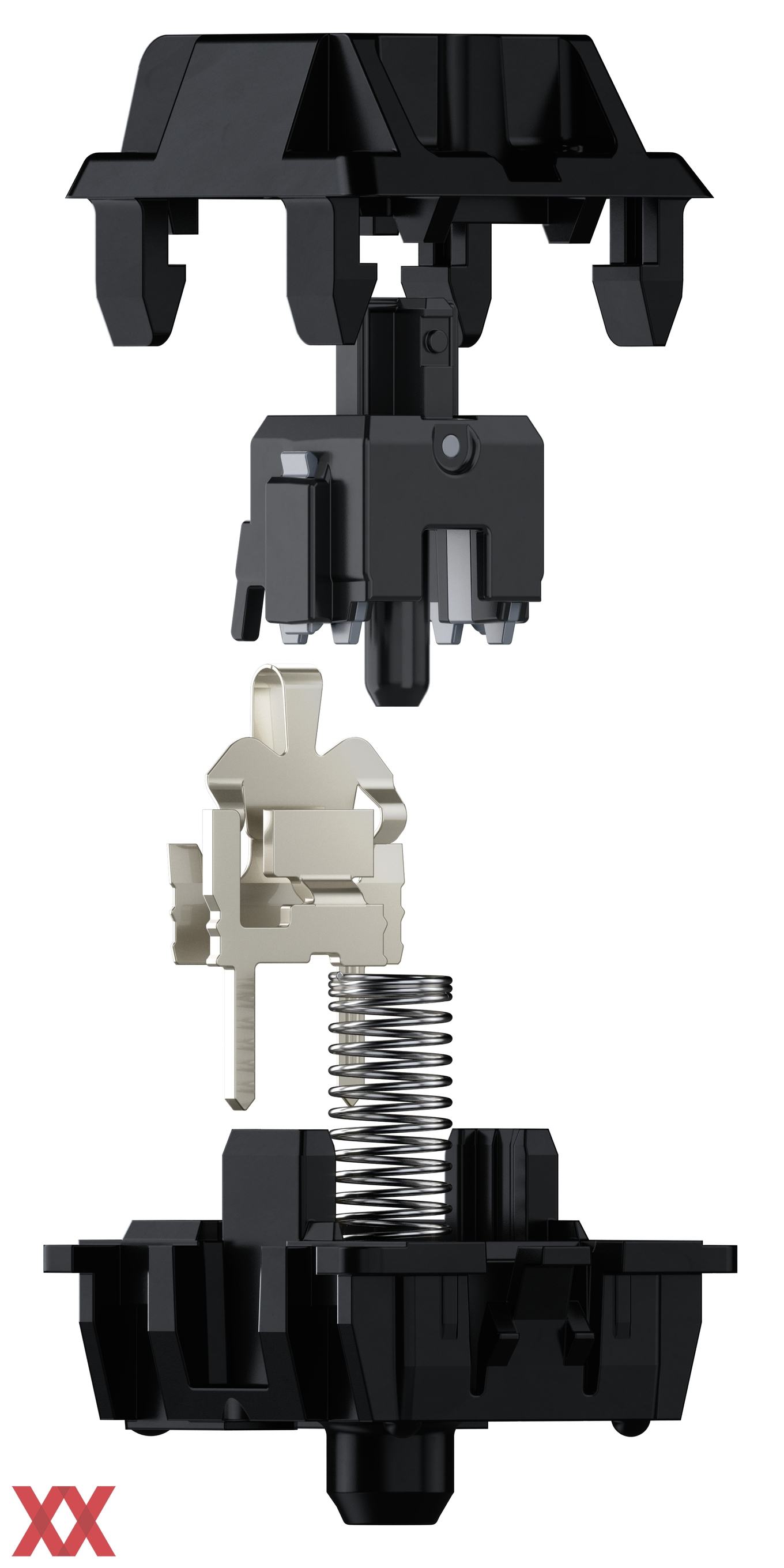
Actuation force: 50 g
Travel distance: 2 mm
Structure: linear
Pressing feeling: vertical, moderate pressing force, clear rebound
Scene: games, typing, daily work (all scenes)
Sound: relatively quiet
Gateron Black Switch
Those who love the strong feedback and prefer a smooth and stiff feedback should look into Gateron Black switches. The black switch is a linear switch with the greatest strength amongst standard mass-produced switches. The benefits of the strong actuation force is more pressure with a stronger mechanical feedback, making it harder to press the wrong key. Those who like mechanical keyboards, a stronger trigger force will likely prefer the Gateron black switch.
Actuation force: 60 g
Travel distance: 2 mm
Structure: linear
Pressing feeling: vertical, strong pressing force, hard rebound
Scene: game, typing
Sound: medium
Gateron Green Switch
Gateron’s Green switch is seen by many as an upgraded version of Gateron’s Blue switch.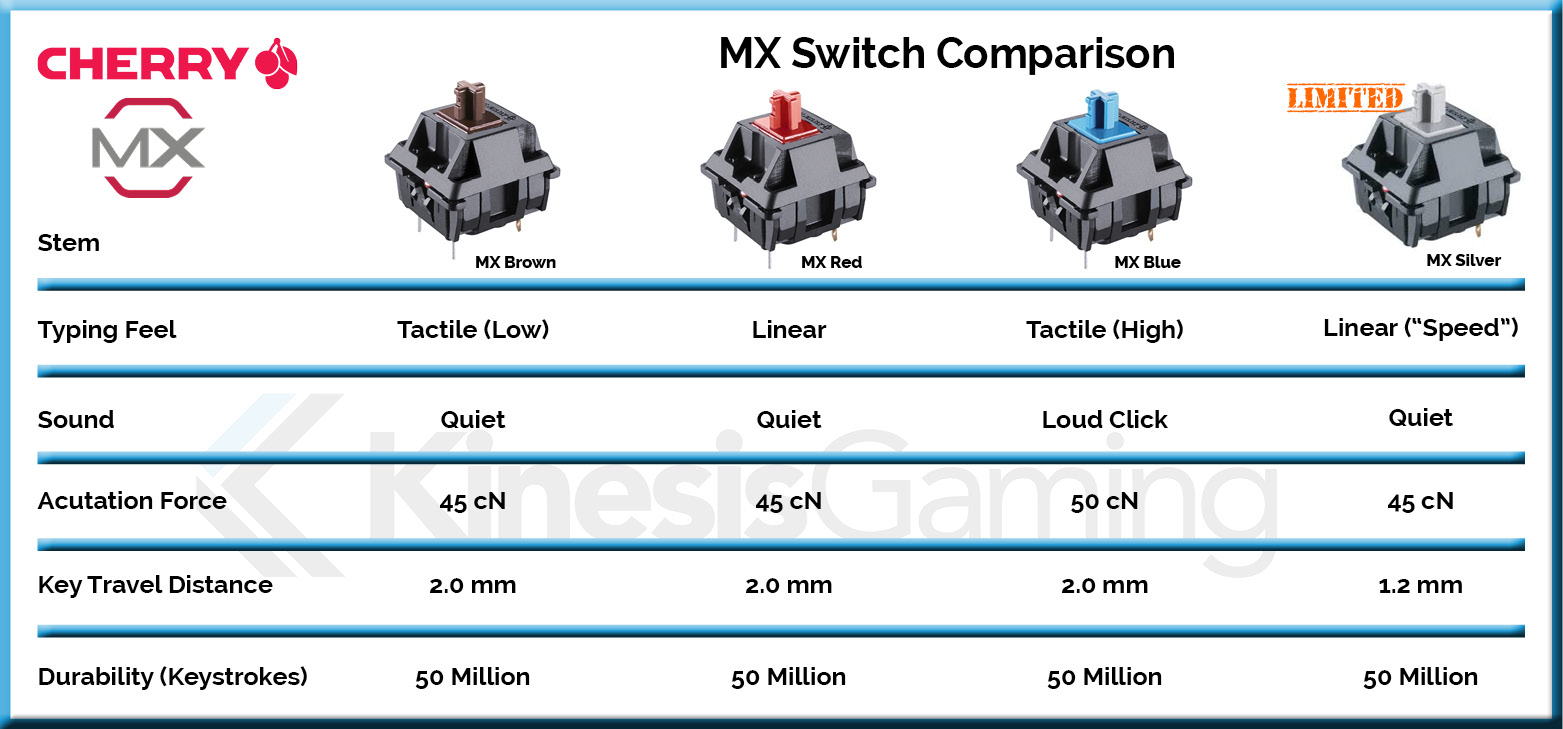
Actuation force: 80 g
Travel distance: 2 mm
Structure: clicky
Pressing feeling: clicky, strong pressing force, hard rebound
Scene: typing
Sound: clicky
KEYCHRON GATERON SWITCHES KEYBOARDS
Cherry MX Blue, Brown and Red – what is the difference between mechanical key switches
Mechanical keyboards are already quite firmly entrenched in the gaming market and not only peripherals. Yes, they are not cheap, but they have a number of significant advantages. Also, very often manufacturers release the same keyboard model with several types of switches – and users naturally have a question about which type of keys to choose for themselves. To sort out this confusion a little, we have prepared this material for you, and as an example we will use the HyperX Alloy FPS model, kindly provided by Kingston.
Course
PR-COMMUNICATIONS
Promote the image of the company, and become a PR shark? Easily!
Vivchiti course
The reason for writing this article was the appearance on sale of new modifications of the HyperX Alloy FPS keyboard. As you remember, we really liked this model (you can read the review of the keyboard at this link). It went on sale only with Cherry MX Blue switches, which could stop those who prefer not only high-quality “mechanics” but also silence from buying. The keyboard is now also sold with Cherry MX Brown and Red switches. Structurally, the novelties do not differ from the model with which we have already met, the difference lies only in the type of switches.
Table of contents
- 1 What’s so special about Cherry switches and why should you consider mechanical keyboards?
- 2 Cherry MX Blue
- 3 Cherry MX Brown
- 4 Cherry MX Red
- 5 Summary
What is it about Cherry switches and why you should pay attention to mechanical keyboards?
Each Cherry switch is manufactured in Germany at the Bayreuth factory.
If you have used only membrane keyboards, you may have noticed that the keys lose their properties over time, which they possessed for the first time after purchase. This is due to the fact that the silicone membrane that underlies such keyboards dries out over time or, conversely, stretches, which leads to a change in tactile sensations during operation. Mechanical keyboards do not have such a disadvantage, and the moment when the mechanical switch loses its original properties will occur much later – and it is not a fact that it will be possible to catch it. This is important primarily for those who are associated with typing large amounts of text and intense gaming sessions.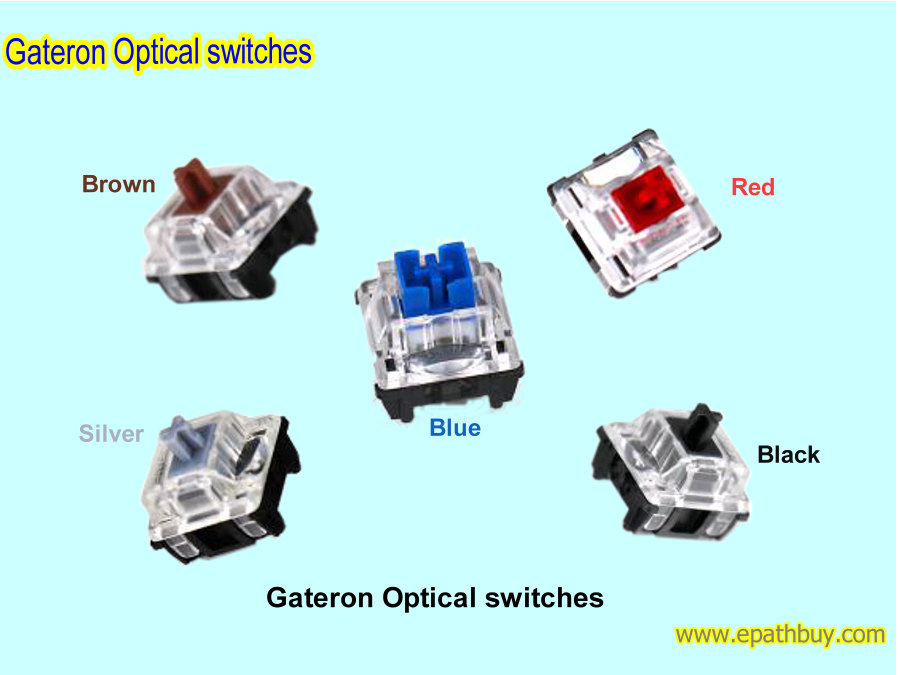
So, there are several types of switches in the Cherry MX line, and there are only four main and most popular ones: Blue, Brown, Red and Black. They are named because of the color in which the base of the mechanism is painted. There are more of them, but the most commonly used by manufacturers are those listed. Each of them has its own properties that directly affect the comfort during play or work.
This type of key is characterized by a tactile response approximately in the middle of the stroke. Pressing the key, halfway through you will feel a slight stop, and after it passes the key will make a fairly loud click. The last moment will be a drawback for many, since during fast typing, the keyboard will sound like a typewriter from the beginning of the 20th century, which will negatively affect acoustic comfort. But if the sound does not bother you or others and you need to dial a lot and regularly, then pay attention to the “blue” switches. The force required to press is approximately 45 grams, which is quite a bit even for not very strong fingers.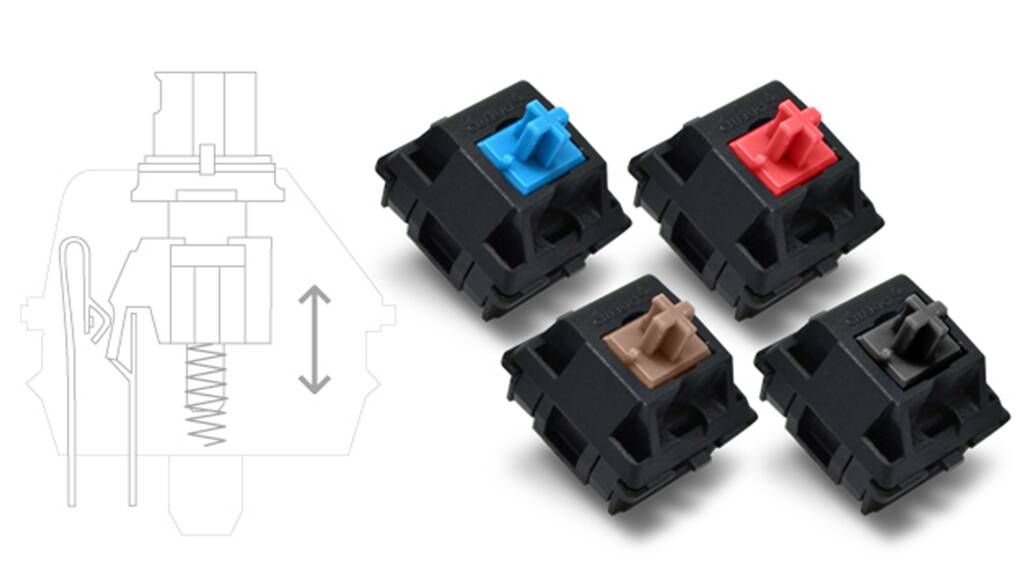
Course
Strategic Marketing
You can’t sell a pen… and style… and style
I want to go to the course
We didn’t just place the “left” switches next, since they are very similar in their characteristics to MX blue. With the exception of one feature – they are almost silent in operation. The only sound they can make is the impact of the cap on the base of the keyboard, but this is not necessary, since pressing, as in the MX Blue, occurs approximately in the middle of the key travel. The switch has a tactile response at the moment of actuation, but not as pronounced as the “blue switches” have. Cherry MX Brown are, in our opinion, the most balanced switches, as they are well suited for both typing and gaming, and at the same time they will not piss off others.
This type of switch has the most significant difference from the above: it lacks tactile and audible feedback when pressed and its travel is linear along its entire length.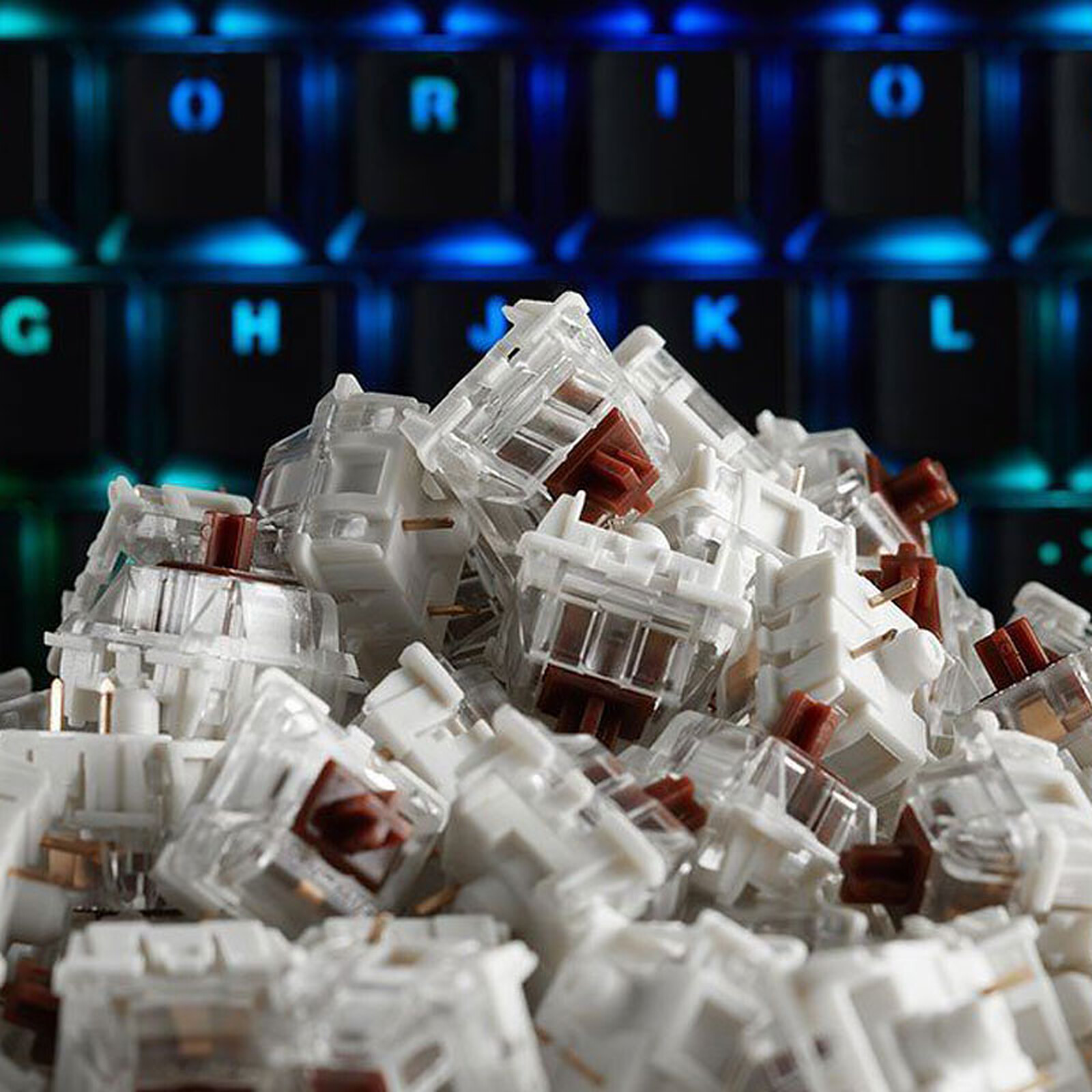
Cherry MX Red has a sibling called MX Black, which has the same properties, with one exception – the force required to press is 60 grams, and from personal experience it is worth noting that the “black” switches are only good for games , but not for typing, no matter how strong your fingers are. The increased stiffness of the spring requires more force when pressed, and typing large amounts of text, unfortunately, is not a comfortable experience. The HyperX Alloy FPS model is not available for sale with this type of switches, but we could not help but tell about it.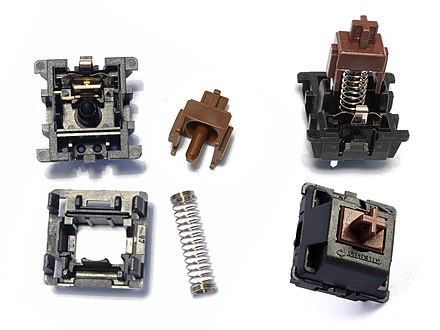
Results
We hope that in this article we have clarified some issues related to mechanical keyboards. Of course, “mechanics” is not a panacea in games and work, but it has its own advantages. As for the question of which mechanical switches to choose, it cannot be answered unambiguously, but you can try. If you play more than you type, take a look at Cherry MX Red\Black. If typing is a priority, then you should look at Cherry MX Brown. In addition to all the advantages of “blue” switches, they have one indisputable advantage – silence in operation.
How to choose a mechanical keyboard for a programmer or gamer / Habr
For the most part, mechanical keyboards are superior to membrane keyboards in several ways. But the choice of the keyboard is not limited to cutting off all instances of the “membrane” class. Mechanical keyboards are also very different. And how do you find the one and only?
First, we will quickly recall how these two basic classes of keyboards differ, and then we will gradually come to the answer to the question posed.
1. Number of rollovers (KRO): Membrane keyboards typically have 2 (2KRO), 3 (3KRO) or 6 (6KRO) rollovers. Mechanical ones have no such restrictions at all (NKRO). It doesn’t matter how many keys you press at the same time: the computer will receive and process the appropriate signals from each of them.
Mechanical keyboards are ideal for programmers and other professionals who actively use hotkeys in various combinations. There are those who need a good keyboard not only for work – gamers. Other users may limit themselves to membrane keyboards.
2. Keyfeel : Membrane keyboards have keycaps above rubber caps with a solid polymer membrane underneath. Unlike membrane keyboards, all keys of mechanical keyboards are equipped with individual switches (which consist of a spring and a rod). Most users like the second option: it feels more pleasant to type.
A good mechanical keyboard can help combat fatigue from prolonged typing.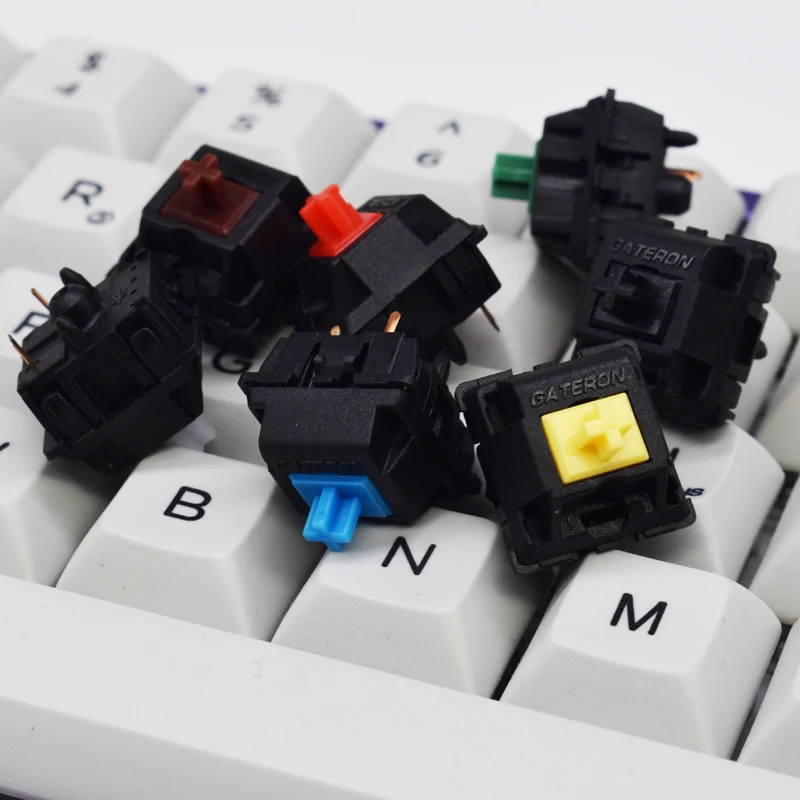
3. Lifespan : Conventional membrane keyboards are rated for 5 million keystrokes. Mechanical keyboards can survive 50 million keystrokes. If, for example, you type for 6 hours (and 1 hour is 60 minutes) a day and make 30 keystrokes per minute, then the life of a mechanical keyboard will be almost 12 years: 50 million / 365 / (6 * 60 * 30) . According to more skeptical estimates – from 3 to 5 years.
More about switches
When choosing a mechanical keyboard, it is very important to pay attention to the switches. The simplest thing to note is that they differ in color. The most common on the Russian market are black, brown, blue and green.
Consider the most important technical characteristics of the switches and their types.
Actuation force
The actuation force (measured in grams) is the level of force that must be applied to make a mechanical switch actuate. It is usually expressed in grams for convenience.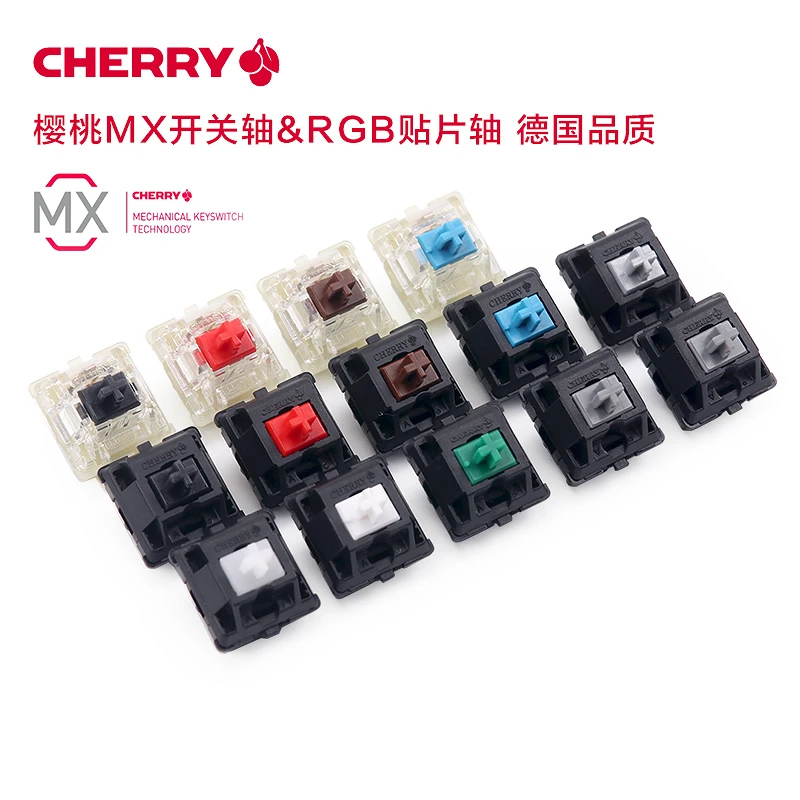
Stroke
The key travel is the distance it travels from the moment it is pressed to the moment it is actuated. By the way, laptop keyboards have a shorter stroke length than standard standalone desktop keyboards. Typically, the travel length of desktop keyboards varies from 3mm to 4mm.
Switch types
There are three types of switches – linear, tactile and clicky.
Clicky switch: as you might guess, these switches make a specific click (“click”) after pressing the keys. It is important to understand that they sound much louder than other mechanical switches. If you are not working alone, it can annoy those around you. Perhaps in this case, such a keyboard will not suit you.
Tactile switch: tactile switches immediately before pressing the key to the stop make it feel like the key travel slows down a bit – as if it overcomes some kind of obstacle (a “tactile push” occurs).
Linear Switch / Even Actuation Switch : Linear switch key travel is very smooth and even. It goes smoothly and without a click. The resistance when pressed slightly increases just before reaching the bottom. Many gamers love keyboards with these switches because they want predictable and preferably fast response times.
Cherry MX switches
The Cherry MX brand has become synonymous with quality in the mechanical keyboard switch market. Therefore, here we consider the main types of switches from this manufacturer.
Black
This is a linear switch with a very smooth action and quiet sound. Its actuation force reaches 60 grams. That is, it requires more effort than the MX Brown and MX Blue (which are discussed below). Cherry MX Black appeals to gamers – especially those who like to play real-time strategy or shooters.
Red
Similar to Cherry MX Black: also linear and quiet (muffles the sound of plastic hitting plastic both when the button is pressed and when it is released).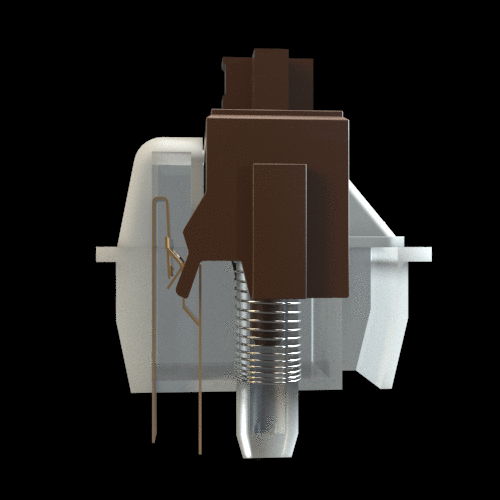
Blue
It makes a click like a typewriter. However, this click is not so loud and nasty. This feature allows you to more clearly feel the actuation point of the switch. However, the keys are light enough to press, so the fingers don’t get tired when typing.
Brown
They are considered universal switches: quiet enough, because there is no click, but at the same time the actuation point is felt quite well (it is easy to determine when it is time to release the key without squeezing it completely). This feature will please those who work a lot with text. But if you don’t know exactly what you want, feel free to take Cherry MX Brown.
How to make a final decision?
Well, you already understood at the beginning that you need to take a mechanical keyboard. Further understood that it is possible to choose one of three types of switches.
Think three extras.
Multimedia keys: It’s important for someone to have separate keys for simple things like adjusting the volume. It also depends on personal preference.
Ergonomic design: The left and right sides of the keyboard are separated to form an angle that matches the natural hand position. It seems to some that this is exactly what a real ergonomic design should be.
Wrist rest: Some users may feel uncomfortable entering text without it. It depends on personal needs.
Run the final experiment
The pros and cons described in this article and, moreover, the recommendations do not claim to be the ultimate truth. For different users, their own experience may be more important. This is especially important when it comes to choosing switches.
